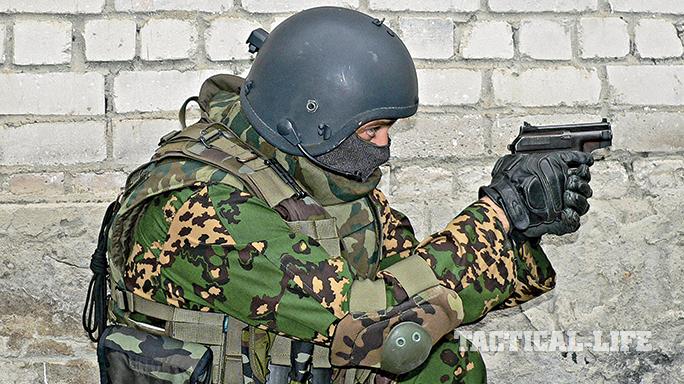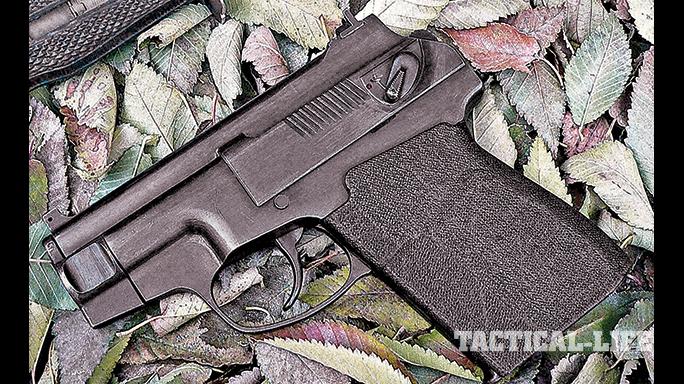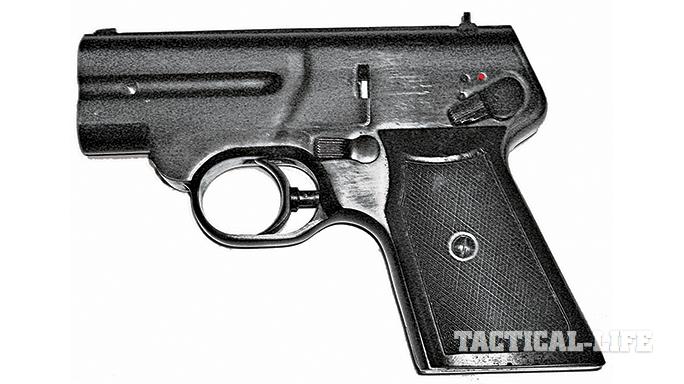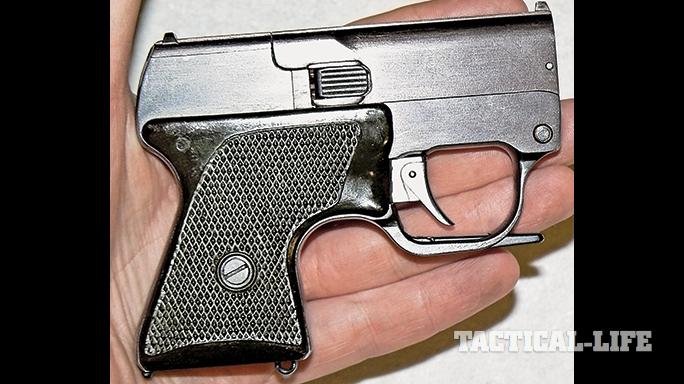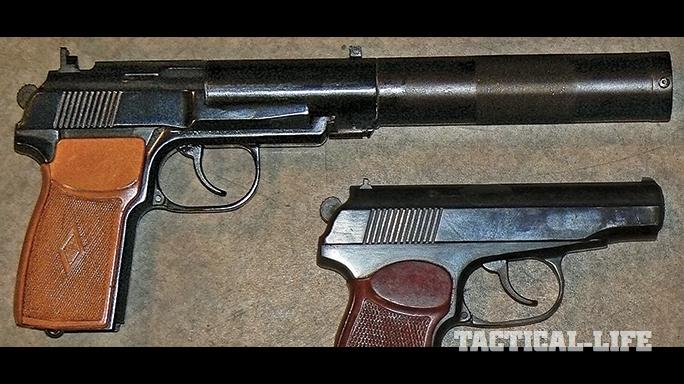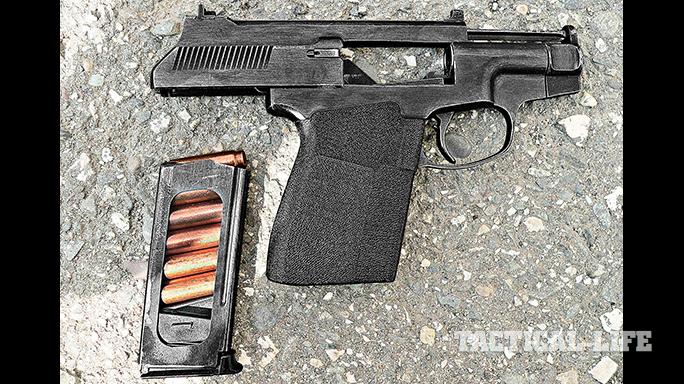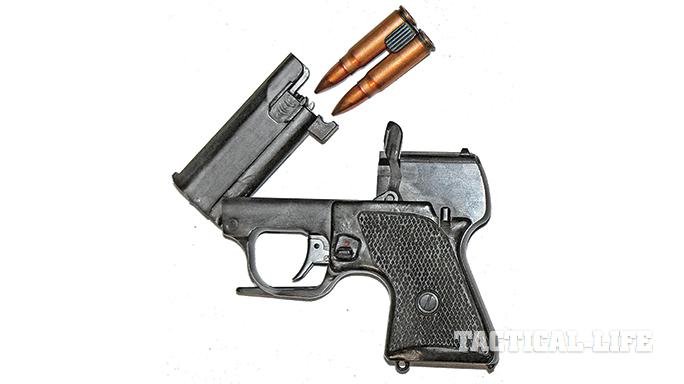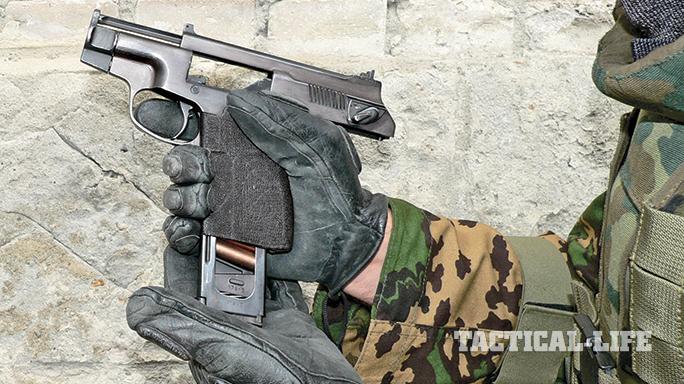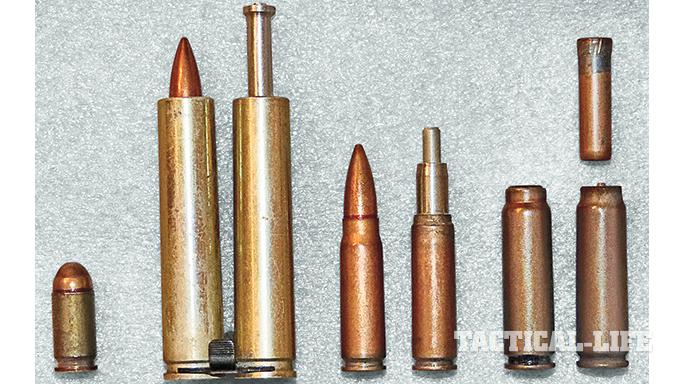The Soviet Army and NKVD (internal affairs) officers began to use suppressed weapons during World War II. Those weapons included the Mosin 1891/30 rifle and Nagant M1895 revolver, both fitted with a Maxim-type quick-detachable suppressor known as Pribor Bramit, or the Bramit device. The 1891/30 rifles were used with special subsonic ammunition, often handloaded by troops. This process involved disassembling the standard round, removing most of the powder charge and filling the empty space with some inert filler.
- RELATED: Running Red: 20 Top AK-47s & Soviet Weapons
- RELATED: 12 Products That Will Enhance Your AK Rifle
Suppressed Nagant revolvers were most often used with special ammunition loaded to standard velocities (which happened to be subsonic), but loaded with a pointed bullet that ensured longer service life of the rubber baffle used in the Bramit silencer.
For some period after WWII, suppressed weaponry disappeared from the Soviet military scene, as the military minds were mostly occupied with nuclear bombs and missiles. However, the appearance of NATO’s tactical nuclear missiles in Europe brought to life the idea of “missile killers”—elite stealth units capable of infiltrating enemy territories to strike at missile launchers, control posts and ammunition dumps at “zero hour.” Obviously, such troops, known as Voiska Spetsialnogo Naznachenija, or Spetsnaz for short, required some special weapons to operate in stealth mode, and suppressed pistols were on the top of their shopping list.
Advertisement — Continue Reading Below
Spec-Ops Hardware
The integrally suppressed Pistolet Beschumnyj (PB) was introduced in 1967 for use by various Spetsnaz units. Manufacture of PB pistols, however, was halted in the mid-1980s, but resumed about 15 years later due to constant demand for such specialized weapons. It was based on the standard issue Makarov PM pistol, fitted with a modified slide, return spring and a semi-detachable suppressor of more or less conventional design. The PB pistol fires standard issue 9×18 PM ammunition. It is still in production in Russia and is used by various army and police special-operations units.
What was more important to our story is that there was another customer for highly specialized small arms within the Soviet “power” system—the almighty Committee for State Security, or KGB. Among other things, the KGB was deeply engaged in espionage and counterespionage operations across the world, with many undercover agents looking for Western secrets while trying to keep Soviet secrets from their Western rivals. This game, obviously, was quite dangerous, and undercover agents sometimes were required to protect themselves with lethal force while maintaining maximum stealth.
Advertisement — Continue Reading Below
Covert Combat
The father of the current breed of covert weapons in Soviet service was Igor Stechkin, designer of the famous APS machine pistol. During the mid-1950s, the KGB requested that he create a deep-concealment weapon that could be disguised as something that looks completely safe and fire poison-tipped bullets without any noise or flash. To achieve the latter effect, Stechkin employed the rather old principle of capturing hot powder gases (the prime source of the sound and flash during the discharge) within the confined space of the specially designed cartridge case.
The first noiseless cartridge developed by Stechkin was designated Spetsialnyj Patron 1 (Special Cartridge Model 1, or SP-1). It was based on a 9×18 case and loaded with a special bullet and a small piston that was located between the bullet base and powder charge. The bullet had the front part of a 7.62mm cartridge, with the base being of 9mm dimensions, and it was intended to be fired through a squeeze-bored barrel with a decreased-caliber muzzle. Essentially, the bullet base was squeezed to 7.62mm dimensions and then free to exit the bore while the piston was jammed into the bore, capturing powder gases inside the barrel.
Advertisement — Continue Reading Below
Of course, this system was to be used only in manually loaded, single-shot weapons. One such weapon (recently declassified) was made to imitate a tin cigarette case, with three 9mm/7.62mm barrels and a firing mechanism fitted inside.
The SP-1 cartridge never went past the prototype stage, but within several years Stechkin designed his next internally silenced cartridge, known as the SP-2. This one also contained a small powder charge behind the piston, but this time the powder gases were to be captured inside the bottlenecked cartridge case, which looked somewhat similar to that of the 7.62x39mm M43 round. Since the pusher piston was relatively short and was seated deep in the cartridge case before discharge, the bullet had to be made long but relatively light. To achieve this, Stechkin used metal jackets taken from unassembled 7.62mm pistol (7.62x25mm) bullets and fitted it with an aluminum core that extended back from the jacket to rest on the piston.
Behind Enemy Lines
Advertisement — Continue Reading Below
The following part of these weapons’ history is very dim at its best, but what is known is that around 1965 the KGB, as well as its most important rival within the Soviet intelligence system, the Intelligence Department of the General Staff of the Soviet Army, or GRU, both adopted the “noiseless pistol complex,” which consisted of the integrally suppressed 7.62mm cartridge, known as Patron Zmeya (PZ), and the two-barreled, derringer-type pistol known as S4.
The PZ ammunition, which was the heart of the system, consisted of the machined, 63mm-long steel case with a screw-in base. It featured a tapered inner bore with single-stage pusher piston inserted from the rear. A small amount of special propellant was loaded behind the piston, and the base was securely screwed in to form an airtight, variable-volume container for powder gases. The cartridge base itself was a complicated subassembly, as it contained a standard primer, a small firing pin behind it and a screw-in bushing to keep the primer and pin in the base under the pressure of powder gases.
The projectile was inserted from the front. It was a standard 7.62mm pointed bullet, as used in 7.62×39 M43 ammunition, used with the possible intent to fool any post-incident investigators and make them search for a sniper who fired an AK or SKS rifle from a stand-off distance, rather than look for a secret agent that shot the target from almost point-blank range.
Advertisement — Continue Reading Below
Muzzle velocity was about 557 feet per second (fps), and resulting muzzle energy was about 84 foot-pounds. Over time, the PZ cartridge evolved through several minor variations before arriving at its definitive version, known as PZAM. It is believed that this weapon complex saw at least some use in the hands of the GRU Spetsnaz during the Soviet incursion into Afghanistan. And, in modified form (S4M pistol and PZAM ammunition), it still can be found in the armories of certain highly specialized units within the Russian military and internal affairs ministry.
Enhanced Design
While more or less effective in use, the S4 series apparently still left something to be desired, especially from the point of view of the plainclothes agents of the KGB and GRU. Both the pistol and its ammunition were too heavy and bulky for their intended use, and during the late 1960s Igor Stechkin returned to the drawing board with the intent to design a more compact weapon of comparable performance. He started with ammunition.
Advertisement — Continue Reading Below
The limiting factors in size and weight of the internally suppressed ammunition are the strength of the case (which has to withstand high pressures without bursting) and the length of the piston, which takes space between the bullet and the powder load. The case-strength issue was apparently solved through the use of a special, reduced-power propellant and by allowing the case to be fire-formed at the neck by the moving piston when fired. The piston’s length was also decreased through the adoption of a two-part, telescoping piston.
Of course, the two-part piston is more complicated and thus expensive to make, but during the Soviet era, the KGB budget was never short for new toys. In fact, it is possible that this new cartridge was still less expensive than the PZ series due to the use of a single-piece, drawn steel case with a conventional primer instead of the multi-part machined steel case of the PZ series.
The load for the new round was the same M43 bullet, weighing 122 grains, but the muzzle velocity dropped to about 475 fps, resulting in muzzle energy of only 61 foot-pounds—about half that of .32 ACP ammunition. This performance may look quite marginal at its best, but one must remember that this ammunition used relatively heavy-pointed bullets, which provided better penetration than lighter, blunt-nosed pistol bullets. It’s also worth noting that this gun was to be used by highly trained personnel who knew where to put each bullet for maximum effect.
Advertisement — Continue Reading Below
With the new SP-3 ammunition in hand, Stechkin and his team at the Tula arms factory then developed another derringer-type, break-action pistol with two barrels. It was adopted by the KGB and Soviet military in 1972 as the Malogabaritnyj Spetsialnyj Pistolet (MSP), and it still remains in limited service with elite units in Russian law enforcement and anti-terrorism units.
Maximum Effect
While the MSP was close to ideal for KGB purposes, it still left a lot to be desired from the military’s point of view, especially in terms of ammunition capacity. Therefore, in the late 1970s, a requirement was set by the Soviet Army to develop a multi-shot, self-loading, compact weapon that would fire internally silenced ammunition. The problem, however, was that existing “noiseless” ammunition was either overly bulky (as in the case of the 7.62x63mm PZAM cartridge) or badly suited to self-loading applications (as with the 7.62x37mm SP-3, which had a protruding telescoping piston and a case that expanded at the neck during discharge). Therefore, the work commenced with development of the new ammunition, which was better suited for self-loading applications.
Advertisement — Continue Reading Below
Since the users of the proposed weapon were intended to operate in circumstances where foreign criminal investigations of its results would be irrelevant, it was decided to use a specialized bullet—one optimized for penetration and stopping power at relatively low velocities.
The new cartridge featured a flat-point, cylindrical bullet 35mm long that was made of mild steel with a brass driving band at the front. When fired, this bullet is said to penetrate a standard steel military helmet at 25 yards and still have sufficient killing power to disable the helmet’s owner. The new cartridge, designated as Spetsialnyj Patron 4 (SP-4), employed a bottlenecked case 42mm long with a short neck. When loaded, the bullet is fully seated in the case, with its flat tip being flush with the case mouth. Below the bullet there’s a short steel piston that separates the powder charge and the bullet.
The piston’s diameter is larger than that of the cartridge mouth/bullet diameter, so when the powder charge is fired, the piston jams itself in the cartridge mouth, sealing powder gases inside the case. Like its predecessor, the SP-4 cartridge uses standard primers that are securely crimped in the base. SP-4 propels its 143-grain bullet at 655 fps at the muzzle, resulting in 137 foot-pounds of energy.
With new ammunition on hands, designers at TSNII TochMash commenced the development of a new semi-automatic pistol to fire it. It took about three years to design and refine the unusual and unique firearm, which was adopted in 1982 as Pistolet Samozaryadnyj Spetsialnyj (PSS). It was quite compact, being even shorter than a standard Makarov PM pistol, and featured a conventional six-round, detachable box magazine that greatly increased firepower when compared to earlier two-barreled, noiseless pistols.
The PSS used a simple blowback action and a Makarov PM-type, double-action trigger with an external hammer and manual safety/decocker. This pistol was soon issued to military Spetsnaz units that were to operate behind enemy lines and to specialized KGB units, such as the famous anti-terrorism unit “A” (better known as “Alpha” group).
Today, the PSS can be found in the armories of various SWAT-type units across Russia that are engaged in operations against terrorism, organized crime and drug trafficking. Originally top-secret equipment, today it is widely known among Russian gun enthusiasts and professionals alike, and offered for export to qualified foreign government buyers through a Russian state arms export agency.
